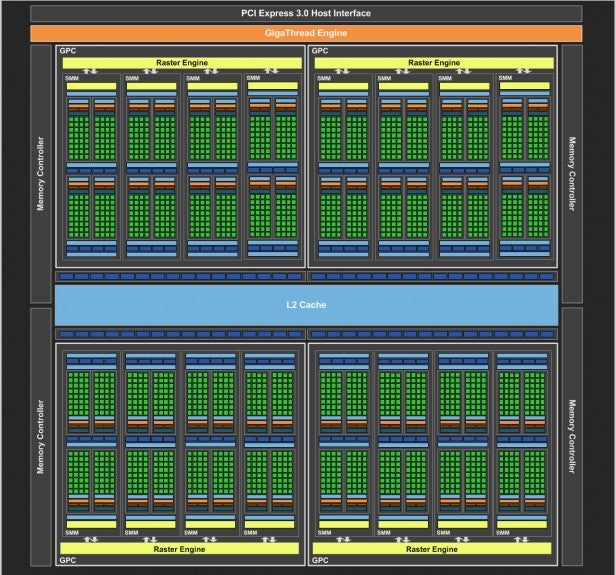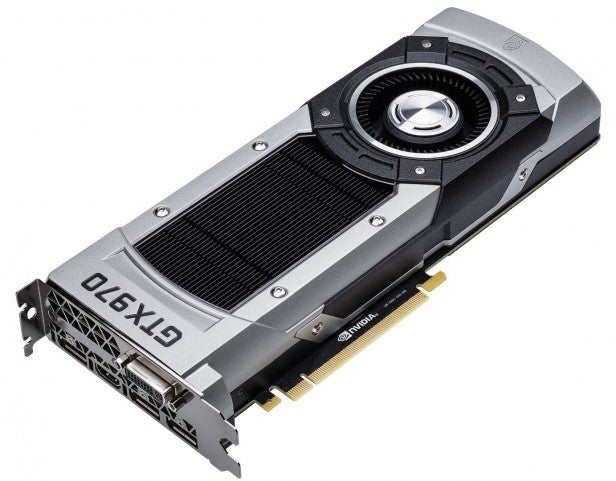Nvidia GeForce GTX 970 Review
Nvidia GeForce GTX 970
Nvidia's second-tier graphics card is ideal for gaming up to 1440p resolution

Sections
- Page 1 Nvidia GeForce GTX 970 Review
- Page 2 Nvidia GeForce GTX 970: Testing Results Review
- Page 3 Nvidia GeForce GTX 970 – Performance Analysis and Verdict Review
Verdict
Pros
- Top-notch 1080p and 1440p gaming
- Impressive efficiency
- Smaller and overclocked SKUs available
Cons
- More expensive than R9 290
- Not able to play 4K games smoothly
Key Specifications
- Review Price: £257.00
- 1,050MHz core clock
- 1,753MHz 4GB GDDR5 memory
- 5.2 billion transistors
- 1,664 stream processors
- requires 2 x 6-pin power connector
What is the Nvidia GeForce GTX 970
The Nvidia GeForce GTX 970 sits in the middle of Nvidia’s latest range, but it’s not got new hardware inside – its Maxwell architecture first debuted in 2013’s mainstream GTX 750 Ti card.
Here, though, it’s a far more formidable GPU. It’s constructed using 1,664 stream processors – the 750 Ti only had 640 – and it’s paired with 4GB of GDDR5 memory. It’s clocked to a potent 1,050MHz, and that figure can rise to a maximum boost speed of 1,250MHz.
Nvidia GeForce GTX 970: Under the Hood
It’s the same GM204 core that’s deployed inside the range-topping GTX 980, although that card has an even more impressive specification: 2,048 stream processors and a higher base clock of 1,126MHz.
Maxwell isn’t just about pure power – it’s about efficiency, too. Nvidia has spent time reconfiguring the organisation of its stream processors in this card, so now they’re arranged into smaller, more plentiful blocks. It’s a move that means tasks can be delegated with more precision, which means that not all sections of the card need to always run at full pelt, so that power consumption and heat can both be reduced.

Despite the impressive specification and efficiency improvements, the GTX 970 is fighting an uphill battle. Its total throughput of 3.49 TFLOPS is impressive, but AMD’s Radeon R9 290 – a card that’s around £30 cheaper – serves up 4.84 TFLOPS of power.
The GTX 970’s memory situation isn’t great, either. There may be 4GB of GDDR5 soldered to the PCB, but that’s not the whole story: half a gigabyte of that memory is partitioned into a slower section that’s used for less demanding workloads, which means that only 3.5GB is available for high-end games. That’s not the only issue – Nvidia’s initial specification lists said that the GTX 970 had 64 ROPs and 2MB of cache, but it’s actually got 56 ROPs and 1.75MB of cache.
Partitioned memory or not, though, the GTX 970 can’t compete with the R9 290 here, either – at least on paper. Nvidia’s card has a total memory bandwidth of 224GB/s, while AMD’s hardware ramps that up to 320MB/s.

How We Tested
We’ve locked and loaded five games for this GPU test. Battlefield 4, Bioshock Infinite and Crysis 3 all return from our previous reviews, and we’ve added Metro: Last Light and Batman: Arkham Origins to the mix. We’ve tested at 1,920 x 1,080, 2,560 x 1,440 and even 3,840 x 2,160 to see which card is best across single-screens – and to check if any of them can handle 4K.
We’ve used 3D Mark’s Fire Strike test and four Unigine Heaven benchmarks to test theoretical performance, and we’ve taken idle and load temperatures and power requirements to see which card is the coolest and most frugal.
Our test rig consists of an Asus X79-Deluxe motherboard, Intel Core i7-4960X processor, 16GB of RAM and a 1TB hard disk.
To get prices for each card we visited www.scan.co.uk and noted down the cheapest stock-speed card we could find, although we will be referring to the various overclocked and tweaked models available for each GPU, which will be more expensive, later on in the review.


